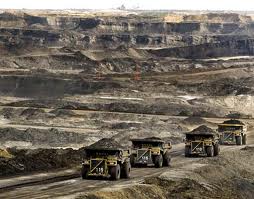
On the same day that I wrote a post about the proposed lignite development in Southland I emailed the Minister for Economic Development, Gerry Brownlee, to express my dismay at the news. I have received a letter in reply which explains all too clearly how such a development could, and presumably will, proceed under current policy.
In my email to the Minister I pointed out that simply offsetting the massive emissions from lignite development would hardly be in line with the intention of the Emissions Trading Scheme (ETS) and the imperative to reduce greenhouse gas emissions. I wrote that unless there are clear plans to capture and sequester the carbon dioxide which will be released the company should not be permitted to undertake any of the proposals. The government is the owner of Solid Energy, able to tell the company it is not to proceed with the plans, and if necessary able to legislate to prevent the development of lignite until such time as sequestration technology is established. I spoke of the Minister’s duty to prevent such development at this time, and stated in conclusion that his obligation to protect our descendants from the potentially terrifying effects of climate change far outweighs any responsibility he carries for present economic development.
The Minister’s reply first assured me that, like me, the Government is concerned about climate change and is committed to doing its “fair share” in reducing New Zealand’s greenhouse gas emissions. The fair share theme is a constant in government statements about climate change these days. It’s a politically useful term: it reminds those who want to do considerably less than we are doing that we can’t afford to appear laggard, and it also serves to placate those who feel we are less than whole-hearted in tackling the issue. It’s hard to argue with, and I can understand its attraction for the government. Nevertheless it’s hardly the kind of term that immediately leaps to mind if one really is concerned about climate change. It suggests that the Government worry is not so much climate change as political positioning.
The Minister goes on to say the ETS is the Government’s principal policy response to climate change. It puts a price on greenhouse gases, he explains, and provides an incentive to reduce emissions and to encourage tree planting. He then adds that it does not provide a cap for existing (or future) emissions and hence is not prescriptive about what developments should or should not progress. This strikes me as a very clear admission that the ETS may not, in fact, result in any reduction of emissions at all. It is a remarkable act of faith in the power of incentives, and an abdication of responsibility for the outcome.
That abdication becomes clearer as the letter proceeds. It is admitted that lignite developments of the scale being investigated by Solid Energy will create significant greenhouse gas emissions, depending on the particular projects chosen. However any development will be “carbon compliant” with New Zealand’s greenhouse gas emission management frameworks. That looks like meaning that Solid Energy will pay whatever is required under the ETS to cover the cost of its emissions, and if the project remains profitable under such a regime it will go ahead whatever the level of its emissions.
But if Geoff Bertram and Simon Terry have it right in their book The Carbon Challenge, Solid Energy, far from paying for the emissions from a plant to manufacture urea from lignite, may well be entitled to subsidies in the form of free emission units for its operations provided it meets certain benchmark standards for ‘emissions intensity’. Bertram and Terry estimate that subsidy could go as high as between $500 million and $1 billion dollars in nominal terms over the first twenty years of the plant’s life. This, even though it would be the country’s biggest single industrial emitter of greenhouse gases after the Huntly power station.
Back to the Minister’s letter. A paragraph follows noting that to potentially mitigate against CO2 emissions Solid Energy is actively following the progress of Carbon Capture and Storage (CCS). The letter referred me to a page on the Ministry of Economic Development website for information about government-industry collaboration on the active investigation of the feasibility of CCS in New Zealand. Maybe I missed something but the page looked pretty sleepy to me. There’s little sign there that CCS is likely to figure prominently in Solid Energy’s lignite projects.
The Minister’s letter then emphasises that projects of this scale have long lead times. He is aware of investigative drilling and pre-feasibility studies, but as yet the decision to commence project construction has not been made. As no formal proposal has been lodged he cannot pre-empt outcomes. I don’t know what pre-empting means in this context, but it seems pretty clear from the rest of the letter that he won’t be looking to create any obstacles.
A final paragraph points out that a development of this scale “that can effectively manage its emissions profile” would provide significant opportunities for New Zealand, maybe even bringing about “a step change” in New Zealand’s growth. Given that the bar for the management of emissions is set so low what this seems to mean is that we’re soon to enjoy major economic benefit from the development of lignite. Am I being unfair in drawing the conclusion that this counts for the Minister ahead of any climate change concern?
The kindest thing one can say of the Minister and the Government he represents is that they have as yet no adequate conception of the magnitude of the threats that come with climate change. I’ll do them the courtesy of presuming that if they did they would have made it very clear by now that the lignite will stay in the ground.
[Mock Turtles]
Like this:
Like Loading...

 Two items during this week highlighted the continuing progress of Solid Energy’s intentions to develop the Southland lignite fields. I therefore provide this depressing update to two Hot Topic
Two items during this week highlighted the continuing progress of Solid Energy’s intentions to develop the Southland lignite fields. I therefore provide this depressing update to two Hot Topic  Ethical oil. That’s what Canada is producing from its massive tar sands operation, according to the newly appointed Environment Minister Peter Kent. I admit to having missed that dimension in what I have read of the oil extraction from tar sands. I understood that when the CO2 emissions from its production is added to the CO2 from its combustion it emits between 10 and 45 percent more than conventional crude. I also understood that the environmental effects of the mining and extraction process are appalling, that restoration undertakings are more promised than real and that First Nation communities are gravely affected. Most telling of all I understood that according to James Hansen if the world wants to have a chance of avoiding dangerous climate change it must not only rapidly phase out coal emissions but also leave unconventional fossil fuels such as oil from tar sands in the ground.
Ethical oil. That’s what Canada is producing from its massive tar sands operation, according to the newly appointed Environment Minister Peter Kent. I admit to having missed that dimension in what I have read of the oil extraction from tar sands. I understood that when the CO2 emissions from its production is added to the CO2 from its combustion it emits between 10 and 45 percent more than conventional crude. I also understood that the environmental effects of the mining and extraction process are appalling, that restoration undertakings are more promised than real and that First Nation communities are gravely affected. Most telling of all I understood that according to James Hansen if the world wants to have a chance of avoiding dangerous climate change it must not only rapidly phase out coal emissions but also leave unconventional fossil fuels such as oil from tar sands in the ground.
